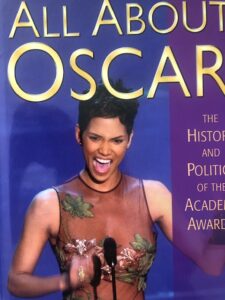One of the very best films Woody Allen has directed in a career spanning over five decades, Hannah and Her Sister is an ensemble-driven feature with serio-comic elements and multiple points of view.
Grade: A (***** of *****)
| Hannah and Her Sisters | |
|---|---|

Theatrical release poster
|
|
An intricately structured family saga, for which Allen won the Original Screenplay Oscar, “Hannah and Her Sisters,” is framed by three family holiday celebrations, all set over Thanksgiving.
During those three years, three disparate sisters–wonderfully played by Mia Farrow, Barbara Hershey, and Dianne Wiest–are introduced, with the text dwelling on their romantic, sexual and familial relationships.
Woody Allen makes an invaluable contribution to the picture as an actor, playing Mickey, a TV producer, essentially a variation of his Jewish neurotic character, hypochondriac and fearful of death except that here, for a change, there’s a happy ending.
Formerly married to Mickey, the eldest sister, Hanna (Farrow), is married to Elliott (Michael Caine), a business manager for rock stars, who’s fooling around with her beautiful sisters Lee (Hershey), who’s living with Frederik (Max Von Sydow), an older, bitter SoHo artist.
The youngest of the trio is Holly (Wiest), an insecure woman and former drug-addict, who changes profession by the day, and resents the most her oldest, most respectable, “perfect” sister, who seems (but only seems) to have everything.
Structurally, the film is divided into chapters, with such titles as “Summer in New York,” “Autumn Chill,” “Lucky I Ran Into You,” “The Audition,” and so on.
The epilogue is set one year later, over a big Thanksgiving dinner, set at Hanna’s household, revealing a new set of relationships and all kinds of adjustments.
Many viewers were impressed with a restaurant scene, in which the camera magnificently circles 360 degrees around the table, while the sisters chat about this and that.
Hannah and Her Sisters was a huge critical and commercial hit, earning over $40 million at the box-office against a modest budget of $6 million.
Unfortunately, the film also signaled the end of the Allen’s position as the foremost American director, an era that began with the 1977 Oscar-winning “Annie Hall,” during which Allen was not only the most famous Jewish director but the most famous and most acclaimed American filmmaker.
My Oscar Book
Oscar Alert
Oscar Nominations: 7
Picture: produced by Robert Greenhut
Screenplay (Original): Woody Allen
Director: Woody Allen
Supporting Actor: Michael Caine
Supporting Actress: Dianne Wiest
Art Direction-Set Decoration: Stuart Wurtzel; Carol Joffe
Film Editing: Susan E. Morse
Oscar Awards: 3
Screenplay
Supporting Actor
Supporting Actress
Oscar Context
In 1986, Woody Allen’s serio-comedy “Hannah and Her Sisters,” competed for the Best Picture Oscar with the drama “Children of Lesser God,” Oliver Stone’s Vietnam combat film “Platoon,” which won, the dull historical epic “The Mission,” and Merchant-Ivory period adaptation “A Room With a View.”
The nominations caused a scandal when the helmer of “Children of a Lesser God,” Randa Haines, failed to receive a Best Director nod, probably because of the gender; similar discrimination occurs when both Penny Marshall and Barbra Streisand were snubbed by the Director Branch, despite the fact that their pictures, “Awakenings” and “The Prince of Tides,” respectively, did get Best Picture nominations.
Claire Simpson won the Editing Oscar for “Platoon,” and Gianni Quaranta, Brian Ackland-Snow, Brian Savegar, and Elio Altamura the Art Direction-Set Decoration award for “A Room With a View.”
Intertextuality
Allen has acknowledged the influence of Ingmar Bergman’s 1983 film, Fanny and Alexander on his work. In both films, a large theatrical family gather for three successive years’ celebrations (Thanksgiving in Allen’s film, Christmas in Bergman’s).
The first of each gathering is in a time of contentment, the second in a time of trouble, and the third showing what happens after the resolution of the troubles.
The sudden appearance of Mickey’s reflection behind Holly’s in the closing scene also parallels the apparition behind Alexander of the Bishop’s ghost.
The title might have been inspired by Visconti’s 1960 masterpiece, Rocco and His Brothers.
That film also uses the structural device of dividing sections of the film for the different siblings’ plot arcs.
Cast
Woody Allen as Mickey, Hannah’s ex-husband
Michael Caine as Elliot, Hannah’s husband
Mia Farrow as Hannah
Dianne Wiest as Holly, Hannah’s sister
Carrie Fisher as April, Holly’s business partner
Barbara Hershey as Lee, Hannah’s sister
Lloyd Nolan as Evan, Hannah’s father
Maureen O’Sullivan as Norma, Hannah’s mother
Daniel Stern as Dusty
Max Von Sydow as Frederick, Lee’s domestic partner
Lewis Black as Paul
Julia Louis-Dreyfus as Mary
Christian Clemenson as Larry
Julie Kavner as Gail, Mickey’s production assistant
J. T. Walsh as Ed Smythe
John Turturro as writer
Rusty Magee as Ron
Sam Waterston as David
Richard Jenkins as Dr. Wilkes
Fred Melamed as Dr. Grey
Benno Schmidt as Dr. Smith
Joanna Gleason as Carol
Maria Chiara as Manon Lescaut
Bobby Short as himself
Beverly Peer as bass player
Bernie Leighton as audition pianist
Daisy Previn, Moses Farrow, Fletcher Previn as Hannah’s children, Thanksgiving guests
Credits:
Directed, written by Woody Allen
Written by Woody Allen
Cinematography Carlo Di Palma, A.I.C.
Edited by Susan E. Morse, A.C.E.
Production company: A Jack Rollins and Charles H. Joffe Production
Distributed by Orion Pictures
Release date: February 7, 1986 (US)
Running time: 106 minutes
Budget $6.4 million
Box office $40.1 million











